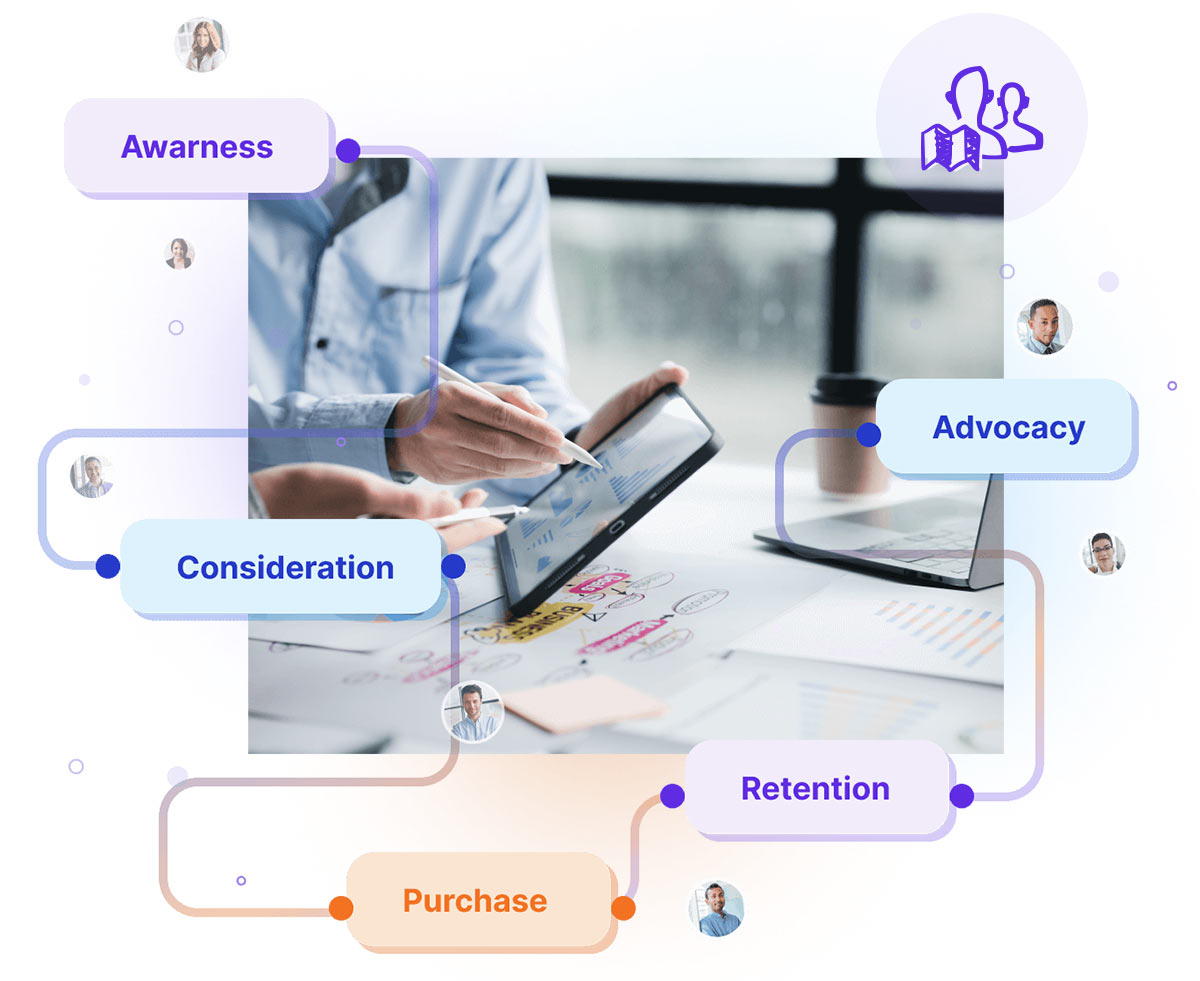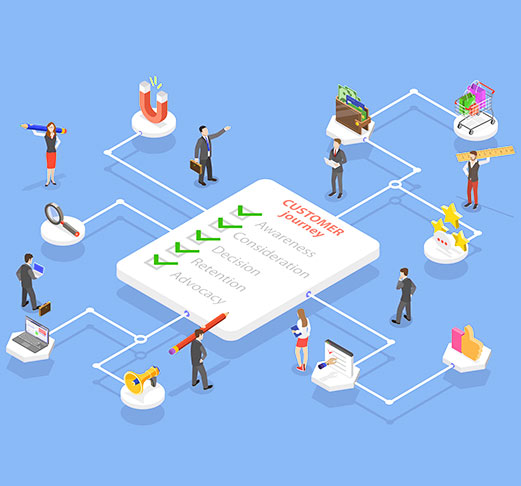Customer Journey
Discover a world of opportunity with customer journey mapping.



Map your customer journey today
What does your typical buyer’s journey look like?
Without customer journey mapping, you’ll never know the answer. A customer journey map is a visual depiction of the journey somebody takes with your company, from first becoming aware of it to buying one of your products.
This visual map helps you to understand the customer’s needs and critical pain points, both of which motivate their decisions. With that understanding, you can create the content your customers need to see to understand that your company delivers what they need.
How does that benefit you?
When you understand the buyer’s journey, you can make use of every digital channel available to ensure your customers understand what’s so amazing about your business. That understanding improves the customer experience, which boosts conversions and customer retention rates.
The Webbuzz customer journey consulting service helps you get to grips with what you need to offer to customers at every stage of their journey.
How customer journey mapping works
Discover the benefits of customer journey mapping.

Customer journey mapping allows you to answer three vital questions about your customers:
- Why are customers searching for what your business offers in the first place?
- What pain points and motivators lead to customers searching for your products or services
- What should a customer expect when they engage with your brand?
By answering those questions, you learn more about the people who buy from you. The more you know about your customers, the stronger your digital marketing materials become. And powerful marketing materials ultimately feed into your company’s digital transformation process.
The benefits of mapping out your buyer’s journey include:
- The ability to refocus digital marketing efforts with an inbound perspective
- Creation of new target customer bases due to your improved understanding of what customers want
- The development of new customer service processes that confront major pain points
- Building a customer-focused mindset throughout your business
- Improving your retention rate for existing customers in addition to making more sales to new clients
What is the process for customer journey mapping?
Every business is different, which means every business needs its own buyer’s journey. Our customer journey consulting service typically follows the steps below to help you to create your map.
However, note that these steps may change depending on your company’s needs and current knowledge base.
Step 1 – Determine Your Demographic
Who are your customers, and what do they need? These are the questions we answer during the first step of customer journey mapping. Knowing more about your customers allows you to create buyer personas to whom you can focus your digital messaging.
Step 2 – Detail Emotions and Experiences at Each Stage
Emotions play a critical role in a customer’s buying decision. We help you figure out what your customers feel at every stage of their journey so you deliver content that aligns with their emotions. We also help you figure out what hurts the most for your customers so you can confront their pain points.
Step 3 – Create a Sales Funnel
Your existing sales funnel informs every stage of the buyer’s journey. It dictates what content you deliver, when you deliver it, and the digital channels you’ll use to communicate. Never fear if you don’t have a sales funnel. Our specialist digital marketing transformation agency can help you build one.
Step 4 – Create Key Performance Indicators (KPIs)
KPIs help you to manage and analyse the performance of your digital strategies. We help you define and track KPIs so you can see what works, what doesn’t, and what you need to tweak.
Step 5 – Identify Touch Points & Define Customer Actions
A customer experiences several touchpoints with your company during the buyer’s journey. Each of those touchpoints has a desired action you want the customer to take. We help you define that action to keep your customer moving on their journey.
What our clients are saying



FAQs
How customer journey mapping works?
Customer journey mapping is a powerful tool for businesses to understand and improve the customer experience.
The process involves charting the interactions between a customer and a business, from the first encounter to post-purchase follow-up.
By visualizing this journey, businesses can gain a deeper insight into the customer’s experience and identify opportunities for improvement.
The steps involved in customer journey mapping include:
- Defining Customer Segments: Identifying the different types of customers and their unique needs and goals.
- Data Gathering: Collecting data from various sources, such as customer feedback, website analytics, and sales data, to fully comprehend the customer journey.
- Journey Mapping: Creating a visual representation of the customer journey, including all touchpoints and interactions with the business.
- Identifying Pain Points and Opportunities: analysing the journey map to pinpoint areas of frustration, confusion, or opportunity for enhancement.
- Developing an Improvement Plan: Based on the insights gained from customer journey mapping, develop a plan for improvement that may involve changes to the customer experience, product offerings, marketing tactics, or other areas of the business.
- Implementation and Monitoring: Implement the improvements and continuously monitor the customer journey to ensure it continues to meet customer needs and deliver a positive experience.
By mapping the customer journey and implementing improvements, businesses can create a more seamless and effective customer experience, leading to increased satisfaction and growth.
Customer journey mapping is a crucial tool for driving customer loyalty and achieving business growth objectives.
What is the process for customer journey mapping?
The process of customer journey mapping can be summed up as follows:
Understanding customer segments: Identify the different types of customers and their specific needs and goals.
Gathering data: Collect data from various sources such as customer feedback, website analytics, and sales data.
Visualizing the journey: Create a visual representation of the customer journey, including all touchpoints and interactions with the business.
Identifying opportunities: analyse the journey map to identify pain points and areas for improvement.
Developing a plan: Based on the insights gathered from the customer journey mapping process, develop a plan for improvement that may involve changes to the customer experience, product offerings, marketing tactics, or other areas of the business.
Monitoring and improvement: Implement the improvements and regularly monitor the customer journey to ensure it continues to meet customer needs and deliver a positive experience.
By using customer journey mapping, businesses can gain a deeper understanding of the customer experience and make data-driven improvements that lead to increased customer satisfaction and business growth.









